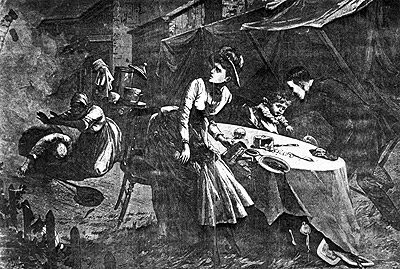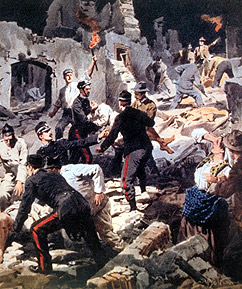Berkeleyan
 |
A magnitude 7.0 quake struck Charleston, S.C., bringing down the garden wall during these residents' dinner. "Not a building in the city had escaped injury in greater or less degree," wrote an eyewitness. (National Information Service for Earthquake Engineering, UCB ) |
A heads-up for the earthquake-prone?
Study shows feasibility of early warning of damaging ground motion from earthquakes
![]()
| 09 November 2005
A Berkeley seismologist has discovered a way to provide advance warning - anywhere from a few seconds to tens of seconds - about impending ground shaking from an earthquake.
While a few seconds may not sound like much, it's enough time for schoolchildren to dive under their desks; for gas and electric companies to shut down or isolate their systems; for phone companies to reroute traffic, airports to halt takeoffs and landings, and emergency providers to pinpoint probable trouble areas. Such actions can save lives and money.
An early-warning system like this is possible thanks to a discovery by Richard Allen, assistant professor of earth and planetary science. In the last five years he has demonstrated that within a few seconds of an earthquake rupture he can predict the total magnitude of a quake and its destructive potential. For example, Allen estimates, it's likely San Francisco could receive 20 seconds' warning of an impending temblor if its epicenter is a fault segment hundreds of miles away.
"We can determine the magnitude within a couple of seconds of initiation of rupture, " Allen says, "and predict the ground motion from seconds to tens of seconds before it's felt." He and his colleagues are now testing a system, ElarmS, that would make these predictions, and the researchers are working with the U.S. Geological Survey (USGS) to determine how accurate these warnings would be.
Seismologists, especially those in the United States, have become increasingly pessimistic about being able to predict earthquakes. Experiments at the intensively monitored Parkfield, Calif., site have dampened enthusiasm that earthquake ruptures might be predicted hours or days before they happen. To reduce loss of life and property, earthquake-prone regions generally rely on a combination of advance preparation and, between five and ten minutes after a quake, post-earthquake assessment and notification of emergency responders.
Allen's early warnings come after a quake rupture has already begun but before the shaking is felt tens of miles from the epicenter. San Francisco sits about midway along the northern half of the 800-mile-long San Andreas fault. If a rupture occurs at the extreme northern end, it could take 80 seconds, traveling nearly 2 miles per second, to reach the city. An early-warning system could provide a critical buffer for residents, businesses, and emergency responders, even if the time isn't sufficient to permit evacuation of a building.
The early-warning information also would feed directly into the new active-response building designs that change the mechanical properties of a structure to let it ride out shaking and minimize damage both inside and out. Active-response buildings are already operational in Japan.
"That is our long-term goal, to have the building feel the earthquake, not the occupants," Allen says.
Two years ago, while at the University of Wisconsin, Allen reported differences in the frequency of seismic signals emanating during the first four seconds of an earthquake, with larger quakes showing lower-frequency signals than smaller quakes. The signal is part of the primary wave, or P wave, that is the first, though least destructive, wave to arrive after a rupture. Most people experience the P wave - a pressure wave that travels through rock like sound through air - as a jolt.
This P wave is followed by a secondary wave, or S wave, that shears the ground back and forth and up and down. Shortly after, more-destructive surface waves arrive that jerk the ground sideways and later roll in like ocean waves.
 Early warning of a severe aftershock would be welcomed by rescuers following a major temblor. Nearly a century ago, soldiers performed that function after a 1907 quake in Calabria (above). (National Information Service for Earthquake Engineering, UCB) |
"Most seismologists are surprised, and frequently skeptical, that you can predict the magnitude of an earthquake before it has ended, but this is telling us that there is something very different from what we thought about the physics of the processes involved in a rupture," Allen says.
Allen's findings conflict with the current model of earthquake rupture. The "cascade" model assumes that earthquake faults are made up of lots of different-size patches, each under some degree of stress. When one of the patches is stressed enough to slip, the slip propagates to adjacent patches, which rupture in turn like falling dominoes. The rupture stops only when the stress propagating along the fault zone reaches a patch too solidly locked to slip.
Inherent in this model is the idea that the initiating rupture is the same for big and small quakes. Allen's findings suggest this is wrong. Instead, the rupture is different for large and small quakes from the beginning, and the initial rupture contains information that can be used to predict the final size.
He proposes, instead, that if the initial rupture generates a large "slip pulse" that travels continuously in all directions across the fault plane, the pulse can supply the necessary energy to propagate through patches that would not otherwise have ruptured. Only when the energy in the pulse drops to a level insufficient to overcome the grip of rock on rock does the rupture stop.
"If the rupture pulse initiates with a large slip, it is more likely to evolve into a large earthquake," he and Olson wrote in their report.
Allen's demonstration that this observation holds in earthquakes around the world, from California to Taiwan and Japan, provides a solid basis for constructing an early-warning system. Once the magnitude of the quake has been estimated, computers can predict areas of serious ground shaking based on an understanding of a particular fault. Within five seconds, warnings could be sent to cities in the areas calculated to expect damaging ground motion.
Because humans couldn't respond fast enough, Allen says, these warnings would have to rely on computers programmed to respond to quakes of a certain magnitude.
"This [would allow] people to get information about an event before the ground starts shaking and the system goes down," he says.
As the rupture proceeds, Allen says, analysis of seismic waves can refine magnitude and ground motion estimates, finally merging into the standard "shake map" typically produced within minutes of the end of an earthquake.
"We're at the stage where we need to test the accuracy of the system, which we're now doing," Allen says. "Next, we will determine whether the telemetry is fast enough to get data to us within seconds of a rupture."
Allen and co-author Erik L. Olson, a former graduate student at the University of Wisconsin, Madison, published their data on early earthquake ground-motion predictions in the Nov. 10 issue of Nature. The work was supported by the USGS, the University of Wisconsin, Madison, and UC Berkeley.

